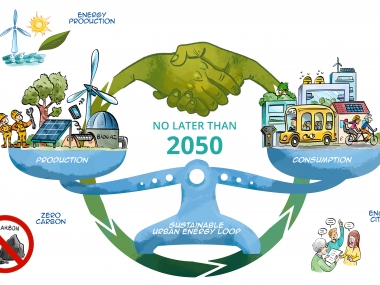Marketing Manager | Posted on | others
Is Sustainable Energy the Way Towards a Net-Zero Future?
0
2495 Views
Greenhouse gas emissions should reach net zero by 2050 and then go negative after that to avoid the terrible effects of climate change and meet the targets as set in the Paris Agreement. Sixty countries and dozens of organisations and localities have already adopted net-zero targets in response to the findings, with many more anticipated to follow suit. In a landmark special report issued, the International Energy Agency stated that the world has a viable pathtowards net-zero emissions by 2050. Still, it is narrow and requires an unprecedented transformation of how energy is produced transported, and used on a global level.

How does Sustainable Energy Play a Crucial Role in Reaching Net Zero?
Sustainable energy is a type of energy that fits our current energy demands without being exhausted and may be utilised repeatedly. Sustainable energy should be widely encouraged because it is environmentally friendly and generally inexpensive. Solar, wind, geothermal, wind energy, and ocean energy are all sustainable energy sources since they are stable and abundant.
Energy sourced from fossil fuels or waste products is not considered sustainable. This energy is renewable, helps us minimise greenhouse gas emissions, and has no negative environmental impact. If we do not stop burning fossil fuels at the same rate, they will run out soon and negatively impact our world. Fossil fuels are not considered sustainable energy sources since they are limited, harm the environment, and are not available everywhere on the earth.
What is Net-Zero?
Net-zero means there are no more emissions emitted into the atmosphere. Emissions will continue, but they will be countered by absorbing an equal amount from the atmosphere. Almost every country has signed the Paris Climate Agreement, which aims to keep global temperatures below 1.5°C above pre-industrial levels. However, suppose we continue to emit the greenhouse gases that cause climate change. In that case, temperatures will climb well above 1.5 degrees Celsius, threatening the lives and livelihoods of people worldwide.

This is why many countries are pledging to achieve carbon neutrality, or "net-zero" emissions, in the coming decades. It's a huge responsibility that will necessitate bold acts beginning now. The goal here is to reach net-zero carbon emissions by 2050. Countries must, however, show how they will get there. Efforts to achieve net-zero emissions must be accompanied by adaptation and resilience measures and the mobilisation of climate finance for developing nations.
How Can We Reach Net-Zero?
To attain zero emissions, no greenhouse gases such as carbon dioxide (CO2), methane, nitrous oxide, or other greenhouse gases should be emitted into the environment. Even after net-zero is achieved, some gases will still be released into the atmosphere. Still, these are offset by taking an equivalent amount of greenhouse gases from the atmosphere and permanently storing it in soil, plants, or materials. Because eliminating some sources of emissions would be excessively expensive or disruptive, reaching net-zero emissions is regarded as more realistic than achieving zero emissions on a national basis.
The key to reaching Net zero is sustainable energy. One good thing is that the technology to go to net zero exists and is accessible. Sustainable energy is a significant component, with polluting coal, gas, and oil-fired power plants replaced with sustainable energy sources like wind and solar farms. Furthermore, sustainable energy is now cleaner and frequently less expensive than fossil fuels.
Switch to Sustainable Energy for a Better Tomorrow
Sustainable energy is the way for countries to one day reach their goal of net-zero. They are environmentally friendly because they are very sustainable. Their inexhaustibility and lack of environmental impact make them an ideal alternative for future energy demands. To reach the huge goal of net-zero, every individual needs to do their part. To switch to sustainable energy and reduce the impact of increasing PECO electricity rates, we recommend that you connect with a sustainable organization to make sure you're able to transition smoothly.
